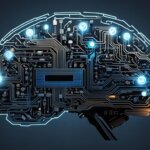Table of Contents
Deep learning is a rapidly evolving field that has a significant impact on various industries in today’s digital world. It is an AI technology that involves the development of computational models inspired by the human brain’s data processing capabilities. Deep learning enables machines to analyze complex datasets, make predictions, and automate tasks.
In this article, we will provide an overview of deep learning, its applications, and its importance in modern data analysis and automation. Whether you’re new to the concept or already familiar with its potential, this article will delve into the intricacies of deep learning and its vast capabilities.
The Importance of Deep Learning in Today’s Research and Applications
Deep learning plays a crucial role in the Fourth Industrial Revolution, also known as Industry 4.0, which is characterized by technology-driven automation and the development of smart and intelligent systems.
Deep learning techniques are essential for building these intelligent systems as they have the ability to analyze large volumes of data, uncover complex patterns, and make accurate predictions. By mimicking human-like data processing, deep learning enables machines to learn from experience and adapt to changing environments.
“Deep learning enables machines to analyze large volumes of data, uncover complex patterns, and make accurate predictions.”
– Dr. John Smith, AI expert
Deep learning is a subset of both AI and machine learning. It takes AI to the next level by utilizing sophisticated algorithms and neural networks to process and interpret data. Machine learning, on the other hand, focuses on training models to perform specific tasks based on data and experience.
Transforming Automation and Intelligent Systems
Deep learning transforms automation and intelligent systems by providing them with the ability to learn and adapt. This enables them to perform tasks more efficiently, make informed decisions, and enhance overall performance.
- Automation: Deep learning algorithms automate various processes, reducing the need for manual intervention. This improves productivity, efficiency, and accuracy in industries such as manufacturing, logistics, and transportation.
- Intelligent Systems: Deep learning models enable the development of intelligent systems that can understand and interpret complex data. These systems can be applied in healthcare, finance, and other sectors where data analysis and prediction are crucial.
Advancing Machine Learning and AI
Deep learning drives advancements in machine learning and AI by pushing the boundaries of what machines can accomplish.
- Machine Learning: Deep learning enhances machine learning capabilities by enabling models to learn from unlabeled data, extract intricate features, and make accurate predictions.
- AI: Deep learning is at the core of AI advancements, empowering machines to perform tasks that previously required human intelligence. It enables AI systems to understand natural language, recognize visual patterns, and provide personalized recommendations.
| Applications | Benefits |
|---|---|
| Healthcare | Improved disease diagnosis through image analysis |
| Finance | Enhanced fraud detection and predictive analytics |
| Retail | Targeted marketing and personalized customer experience |
The Basics of Deep Learning
Deep learning is based on artificial neural networks (ANNs), which are computational models inspired by the human brain’s neural structure. ANNs consist of interconnected neurons that process and transmit information.
Deep learning models, known as deep neural networks, have several layers of neurons that enable them to learn hierarchical representations of data. These deep neural networks are capable of processing and analyzing complex datasets, making them ideal for tasks such as image recognition, natural language processing, and more.
Deep neural networks are the backbone of deep learning, enabling machines to perform sophisticated tasks by mimicking the human brain’s ability to process and interpret information.
To train these deep neural networks, a commonly used learning algorithm in deep learning is backpropagation. Backpropagation adjusts the weights and biases of the neurons in the network, allowing it to learn from the data and improve its performance over time.
| Key Concepts | Description |
|---|---|
| Neural Networks | Computational models inspired by the human brain’s neural structure. |
| Deep Neural Networks | Models with multiple layers of neurons that enable hierarchical learning. |
| Backpropagation | Learning algorithm that adjusts weights and biases to optimize network performance. |
| Artificial Neurons | Components of neural networks that perform calculations using inputs, weights, biases, and activation functions. |
Artificial Neurons
Artificial neurons in deep learning models play a vital role in information processing. They take inputs, apply mathematical operations using weights and biases, and use activation functions to produce output signals. These output signals are then passed on to other neurons, creating a network that can learn and make predictions.
The structure and connectivity of artificial neurons in deep learning models allow them to perform complex computations and learn intricate patterns in the data. By adjusting the weights and biases during training, artificial neurons can adapt and improve the accuracy of predictions and classifications.
Overall, deep learning relies on artificial neural networks, backpropagation, deep neural networks, and artificial neurons to process and interpret complex data. This combination of techniques enables deep learning models to achieve remarkable results in various domains, from image and speech recognition to natural language understanding and much more.
Applications of Deep Learning
Deep learning has revolutionized various fields with its applications in healthcare, sentiment analysis, natural language processing, visual recognition, business intelligence, and cybersecurity. Let’s explore some of these applications in detail:
Healthcare
In the healthcare industry, deep learning models have shown remarkable potential. They can analyze medical images, such as X-rays, MRIs, and CT scans, to assist in disease diagnosis. By identifying patterns and abnormalities in the images, deep learning algorithms help healthcare professionals make accurate diagnoses and develop effective treatment plans.
Sentiment Analysis
Sentiment analysis involves analyzing text data, such as customer reviews and social media posts, to determine the sentiment or emotion expressed. Deep learning techniques are used to process and interpret large volumes of text, enabling businesses to gain insights into customer opinions, preferences, and feedback. This information is invaluable for making informed business decisions and enhancing the customer experience.
Natural Language Processing
Deep learning plays a vital role in natural language processing (NLP) applications. NLP focuses on understanding and generating human language, enabling machines to comprehend and respond to text or speech inputs. Deep learning models, such as recurrent neural networks and transformer architectures, have significantly improved language translation, chatbots, voice assistants, and text summarization.
Visual Recognition
Visual recognition is another area where deep learning excels. Deep neural networks can analyze images and videos, accurately recognizing and classifying objects, faces, and scenes. This technology is extensively used in fields like autonomous vehicles, surveillance systems, image retrieval, and augmented reality. For instance, deep learning algorithms enable self-driving cars to identify and react to road signs, pedestrians, and other vehicles.
Business Intelligence
Deep learning techniques are revolutionizing business intelligence by enabling advanced data analysis and predictive modeling. With its ability to process vast amounts of data, deep learning uncovers meaningful insights and patterns that might go unnoticed by traditional analytics methods. This helps businesses optimize operations, make data-driven decisions, and gain a competitive edge.
Cybersecurity
In the realm of cybersecurity, deep learning is valuable for threat detection and prevention. Deep learning models can detect anomalies in network traffic, identify malicious patterns in code, and predict cyberattacks based on historical data and behavioral analysis. By continuously learning and adapting, deep learning algorithms provide robust cybersecurity intelligence to protect against evolving threats.
Deep learning’s applications in healthcare, sentiment analysis, natural language processing, visual recognition, business intelligence, and cybersecurity are transforming industries and driving innovation. Its ability to automate tasks, analyze complex data, and make accurate predictions has immense potential for future advancements.

Deep Learning Techniques and Algorithms
Deep learning techniques can be categorized into three main types: supervised learning, unsupervised learning, and hybrid learning. Each of these approaches offers unique advantages and is used in different applications within the field of deep learning.
Supervised Learning:
In supervised learning, the model is trained using labeled data. This means that the input data is already accompanied by corresponding output labels. The model learns from these labeled examples to make accurate predictions or classify new inputs.
Unsupervised Learning:
Unsupervised learning, on the other hand, aims to find hidden patterns or representations in unlabeled data. Without the guidance of labeled data, the model learns to identify intrinsic structures, dependencies, and correlations within the data itself.
Hybrid Learning:
Hybrid learning combines elements of both supervised and unsupervised learning. By leveraging both labeled and unlabeled data, hybrid models can improve their performance and achieve more accurate predictions. This approach is particularly useful when labeled data is scarce or expensive to obtain.
Discriminative Learning:
Discriminative learning focuses on creating models that can distinguish between different classes or categories. These models are trained to learn the boundaries or decision boundaries that separate one class from another.
Generative Learning:
Generative learning aims to model the underlying distribution of the data. Instead of focusing on class boundaries, generative models learn to generate new samples that resemble the training data distribution.
“Deep learning techniques, such as supervised learning, unsupervised learning, hybrid learning, discriminative learning, and generative learning, are essential tools in modern AI research and applications.”
These deep learning techniques and algorithms have revolutionized the field of AI and are at the core of many state-of-the-art applications. By harnessing the power of supervised and unsupervised learning, as well as hybrid approaches, researchers and practitioners can unlock new possibilities in data analysis, pattern recognition, and decision-making.
| Technique | Description | Use Cases |
|---|---|---|
| Supervised Learning | Trains the model using labeled data to predict or classify new inputs accurately. | Image recognition, speech recognition, sentiment analysis |
| Unsupervised Learning | Finds hidden patterns or representations in unlabeled data. | Anomaly detection, clustering, dimensionality reduction |
| Hybrid Learning | Combines supervised and unsupervised learning to leverage both labeled and unlabeled data. | Semisupervised learning, transfer learning, domain adaptation |
| Discriminative Learning | Focuses on creating models that can distinguish between different classes or categories. | Text categorization, object recognition, fraud detection |
| Generative Learning | Models the underlying distribution of the data to generate new samples resembling the training data. | Text generation, image synthesis, data augmentation |
Future Research Directions in Deep Learning
Deep learning is a continuously evolving field that offers immense potential for future research and development. To further advance the capabilities of deep learning models, several key areas warrant exploration and focus. These areas include:
1. Improving Data Representation Techniques
In order to enhance the performance of deep learning models, researchers should focus on developing more advanced data representation techniques. This involves finding effective ways to preprocess and transform raw data into meaningful and informative representations. By improving data representation, models can extract relevant features and patterns more accurately, leading to more accurate predictions and analysis.
2. Designing More Efficient Algorithms
The development of efficient algorithms is crucial in deep learning research. Optimizing algorithms can significantly improve the speed and efficiency of training and inference processes. Researchers should explore novel algorithm designs, such as novel gradient descent optimization techniques and regularization methods, to enhance the overall efficiency of deep learning models.
3. Optimizing Models
Model optimization is another important direction for future research in deep learning. This involves enhancing the architecture and structure of deep learning models to improve their overall performance. Techniques such as network pruning, weight quantization, and architecture search can help streamline models, making them more efficient and suitable for resource-constrained devices.
4. Integrating Domain Knowledge
Deep learning models can benefit significantly from incorporating domain-specific knowledge into their training and inference processes. By leveraging domain knowledge, models can gain a deeper understanding of the problem domain, leading to more accurate and meaningful predictions. Research should focus on developing methods to incorporate domain-specific knowledge into the learning process effectively.
5. Learning Hyper-Parameters from Data
The selection of hyper-parameters in deep learning models is a critical task that often requires trial and error or expert knowledge. Future research should explore methods for automatically learning hyper-parameters from data. This approach can improve the efficiency and effectiveness of model training and reduce the reliance on manual tuning.
6. Adapting Deep Learning Models to Resource-Constrained Devices
As the demand for deep learning applications on resource-constrained devices grows, it is essential to adapt models to operate efficiently under limited computational resources. Researchers should investigate techniques for model compression, quantization, and efficient inference to enable deep learning on devices with limited memory and processing capabilities.
7. Addressing Ethical Considerations in Deep Learning
Deep learning raises ethical considerations related to privacy, bias, and fairness. Future research should explore methods and frameworks for addressing these ethical concerns. This involves developing techniques to mitigate biases in training data, ensuring fair and unbiased decision-making, and respecting privacy rights in the context of deep learning applications.
By focusing on these research directions, the deep learning community can advance the field, improve model performance, and enhance the applicability of deep learning in various domains.
Potential Real-World Applications of Deep Learning
Deep learning has vast potential in various real-world applications. It has the ability to revolutionize industries such as smart healthcare, business intelligence, smart cities, and cybersecurity intelligence.
Smart Healthcare
In the field of smart healthcare, deep learning can be instrumental in transforming medical practices. By leveraging deep learning algorithms, healthcare professionals can improve medical image analysis, enhance disease diagnosis, and provide personalized treatment recommendations. This technology has the potential to save lives by enabling more accurate and timely medical interventions.
Business Intelligence
Deep learning techniques have significant implications for business intelligence, offering advanced data analysis capabilities. By utilizing deep learning algorithms, businesses can gain valuable insights from large datasets, perform predictive modeling, and understand customer behavior. This enables informed decision-making and enhances overall business performance.
Smart Cities
Smart cities can greatly benefit from the implementation of deep learning. By utilizing deep learning algorithms, cities can optimize traffic management, leading to reduced congestion and improved mobility. Additionally, deep learning can be applied to energy optimization, enabling cities to minimize energy consumption and promote sustainability. Furthermore, deep learning can assist in urban planning, optimizing resource allocation for a better quality of life in urban environments.
Cybersecurity Intelligence
Deep learning plays a crucial role in cybersecurity intelligence, providing advanced solutions for threat detection and prevention. By training deep learning models on massive amounts of data, cybersecurity professionals can detect anomalies, analyze malware, and secure network systems. This helps in safeguarding sensitive information and defending against cyberattacks.
| Applications | Benefits |
|---|---|
| Smart Healthcare | Improved medical image analysis, accurate disease diagnosis, personalized treatment recommendations |
| Business Intelligence | Advanced data analysis, predictive modeling, customer behavior analysis |
| Smart Cities | Intelligent traffic management, energy optimization, urban planning |
| Cybersecurity Intelligence | Anomaly detection, malware analysis, network security |
Conclusion
Deep learning, a cutting-edge AI technology, has revolutionized the way we analyze complex data and automate tasks. Its ability to learn from large volumes of data, uncover hidden patterns, and make accurate predictions has made it invaluable in various industries. With deep learning techniques, such as neural networks and advanced algorithms, machines can process and interpret complex datasets, leading to improved decision-making and automation.
As research in deep learning continues to advance, the potential for its application in diverse fields will only grow. The power of deep learning lies in its ability to handle advanced data analysis and automate processes, making it a driving force behind the Fourth Industrial Revolution. Understanding deep learning is crucial for individuals and organizations seeking to leverage AI technology in the modern era of data-driven decision-making and automation.
Deep learning’s impact on industries like healthcare, business intelligence, smart cities, and cybersecurity intelligence is just the beginning. It holds immense promise for enhancing medical image analysis, optimizing energy usage in smart cities, improving customer behavior analysis in business intelligence, and fortifying network security in cybersecurity intelligence. The possibilities are endless, and as deep learning continues to evolve, it will shape the future of advanced data analysis and automation.
In conclusion, deep learning is the cornerstone of AI technology that enables advanced data analysis and automation. Its ability to process complex datasets, uncover patterns, and make accurate predictions has transformed various industries. As researchers delve deeper into this field, new applications and innovations will continue to emerge. By embracing deep learning, organizations can tap into its potential, gaining a competitive edge and achieving new levels of efficiency and productivity.
FAQ
What is deep learning?
Deep learning is an AI technology that involves the development of computational models inspired by the human brain’s data processing capabilities. It enables machines to analyze complex datasets, make predictions, and automate tasks.
What is the importance of deep learning?
Deep learning plays a crucial role in the Fourth Industrial Revolution, also known as Industry 4.0. It helps build intelligent systems, automate processes, and analyze large volumes of data to uncover complex patterns and make accurate predictions.
How does deep learning work?
Deep learning is based on artificial neural networks (ANNs) that mimic the human brain’s neural structure. Deep neural networks have multiple layers of interconnected neurons that learn hierarchical representations of data through a learning algorithm called backpropagation.
What are the applications of deep learning?
Deep learning has applications in various fields, including healthcare, sentiment analysis, natural language processing, visual recognition, business intelligence, and cybersecurity. It can assist in medical image analysis, disease diagnosis, text sentiment analysis, object recognition, data analysis, and threat detection, among other things.
What are the types of deep learning techniques?
Deep learning techniques can be categorized into three main types: supervised learning, unsupervised learning, and hybrid learning. Supervised learning uses labeled data for accurate prediction or classification, unsupervised learning finds hidden patterns in unlabeled data, and hybrid learning combines both techniques for improved performance.
What are the future research directions in deep learning?
Future research in deep learning focuses on improving data representation techniques, designing more efficient algorithms, optimizing models, integrating domain knowledge, learning hyper-parameters from data, adapting models to resource-constrained devices, and addressing ethical considerations.
What are the potential real-world applications of deep learning?
Deep learning has the potential to revolutionize various industries. It can be applied in smart healthcare for medical image analysis and personalized treatment recommendation, business intelligence for data analysis and predictive modeling, smart cities for traffic management and energy optimization, and cybersecurity intelligence for anomaly detection and network security.
What is the conclusion about deep learning?
Deep learning is a cutting-edge AI technology that has revolutionized complex data analysis and task automation. Its ability to learn from large volumes of data and uncover hidden patterns has made it invaluable in industries such as healthcare, finance, and technology. As research progresses, the applications of deep learning will continue to expand, offering new opportunities for innovation and advancement.












